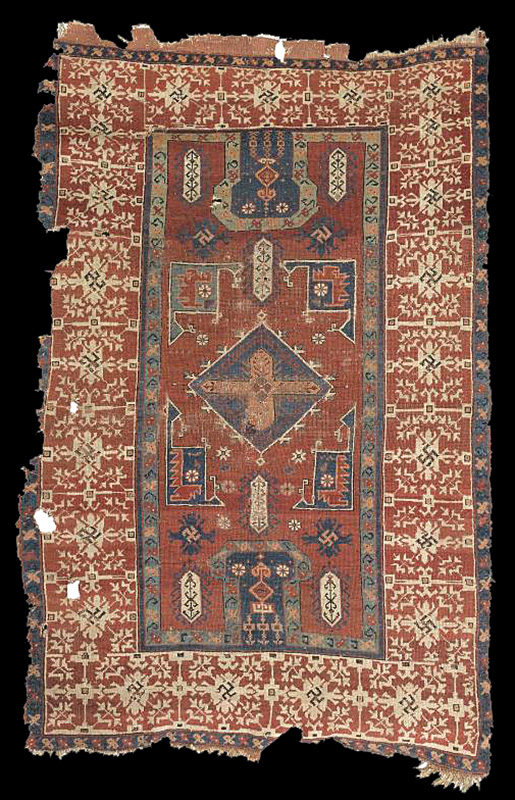|
Sothebys
Sale: N08258 | Location: New York
Auction Dates: Session 1: Thu, 14 Dec 06 11:00 AM
LOT 142 (of 276)
A 'BELLINI' DOUBLE RE-ENTRANT RUG, WEST ANATOLIA,
15,000—20,000 USD
Lot Sold. Hammer Price with Buyer's Premium: 14,400 USD
MEASUREMENTS: approximately 7ft.2in. by 4ft. 10in. (2.18 by 1.47m.)
DESCRIPTION: circa 1700
Condition Note: partial original kilim ends, holes, losses to sides,
oxidized browns, small reweave near center
PROVENANCE
Sotheby's London, 21 April 1999, lot 68
CATALOGUE NOTE
The lot offered here, with its central lozenge medallion and keyhole design,
belong to a group of rugs called Bellini, Keyhole, or Re-Entrant. The most
common denomination is Bellini after the Italian master Gentile Bellini, who
first depicted such weaving in a painting from the late 15th century. The
present lot is a type C rug (according to the classification of Johanna Zick
in 1961) from a sub-group of Bellini rugs that have the double keyhole
design and swastikas in their borders. All works in this sub-group are
believed to be the products of the same village or even the same workshop.
For a thorough discussion and the classification of such rugs see Franses,
Michael, The Bellini Keyhole, Kirchheim, Heinrich, ed., Orient Stars,
Stuttgart, 1993, pp.277-283, and Mills, John, Carpets in Paintings the
Bellini, Keyhole or Re-Entrant Rugs, Hali, Issue 58, pp.86-103. Another
closely related member of this group, differing only in the arrangement of
minor ornamentation and coloring from the offered lot, displaying a red
ground central lozenge medallion rather than a sky blue one and a blue
interior re-entrant guard border rather than a sea green one, is published
in Harmann, Eberhart, Von Uschak bis Yarkand: Seltene Orientteppiche aus
vier Jahrhunderten, Munich, 1979, plate 4. For a remarkably similar rug from
the collection of Herr Dr. Rudolf Lothar, Berlin, see Werner,
Grote-Hasenbalg, Der Orientteppich: Seine Geschichte und seine Kultur, Band
II, Berlin, 1922, plate 18.
The swastika, an archaic religious symbol, is not exclusive to Bellini rugs.
Among others, it is also found on the cloudband border a Lotto rug in the
Keir Collection, see Spuhler, Friedrich, Islamic Carpets and Textiles in the
Keir Collection, London, 1978, No.15, pp.42-3.
 |

